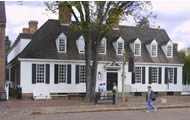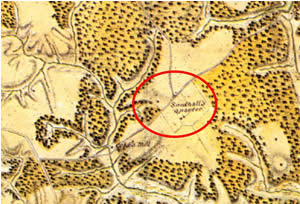Historical Record
 "more Business has been transacted [at the Raleigh Tavern] than on the Exchange of London or Amsterdam"
"more Business has been transacted [at the Raleigh Tavern] than on the Exchange of London or Amsterdam"
-a traveler visiting Williamsburg in 1782 (Bullock 1932:7)
Documentary research suggests that the likely owner of the tract on which Site 44JC969 is located was James Barrett Southall, best known as the proprietor of the renowned Raleigh Tavern in Williamsburg. During the American Revolution and its prelude, the tavern was the site of some dramatic turning points in Virginia's defiance of the British Parliament. Southall was operating a tavern in Williamsburg or its vicinity as early as 1757 when George Washington noted paying "by Supper and Club at Southalls" (Jackson and Twohig 1978:2:202 note). By 1767 Southall was renting and managing Wetherburn's tavern. Under his management, clients including George Washington and John Page referred to that tavern as "Southall's"
 By 1771 Southall had ended his lease at Wetherburn's and purchased the Raleigh Tavern from the estate of Anthony Hay. The Raleigh Tavern would remain under his ownership for 30 years, until he died in 1801. According to the advertisement Hay placed in the Virginia Gazette in 1771, Southall's purchase from Hay included the tavern with a "stable and pasture adjoining." Writing a history of the tavern in 1932, Colonial Williamsburg historian Helen Bullock mentioned that Southall had acquired 19 slaves and "a distant stable and pasture," though she cited no reference for this statement (Bullock 1932:4). The earliest known textual reference in the primary records to Southall's association with a quarter in James City County is an advertisement he placed in the Gazette in 1780 offering his stallion Traveller for stud at his "plantation near Williamsburg." The next year, 1781, when French officer Jean-Nicholas Desandrouins made his map of the landscape around Williamsburg, the spot that corresponds to Site 44JC969 was part of a larger farmstead complex labeled as "Southall's Quarter." By the time of the earliest existing land tax records in 1782, Southall was listed as owning 920 acres in James City County. This is the only property listed for James Southall in the county, and combined with the other more indirect references, it is highly likely that it corresponds to the area labeled as "Southall's Quarter" on the map made the previous year.
By 1771 Southall had ended his lease at Wetherburn's and purchased the Raleigh Tavern from the estate of Anthony Hay. The Raleigh Tavern would remain under his ownership for 30 years, until he died in 1801. According to the advertisement Hay placed in the Virginia Gazette in 1771, Southall's purchase from Hay included the tavern with a "stable and pasture adjoining." Writing a history of the tavern in 1932, Colonial Williamsburg historian Helen Bullock mentioned that Southall had acquired 19 slaves and "a distant stable and pasture," though she cited no reference for this statement (Bullock 1932:4). The earliest known textual reference in the primary records to Southall's association with a quarter in James City County is an advertisement he placed in the Gazette in 1780 offering his stallion Traveller for stud at his "plantation near Williamsburg." The next year, 1781, when French officer Jean-Nicholas Desandrouins made his map of the landscape around Williamsburg, the spot that corresponds to Site 44JC969 was part of a larger farmstead complex labeled as "Southall's Quarter." By the time of the earliest existing land tax records in 1782, Southall was listed as owning 920 acres in James City County. This is the only property listed for James Southall in the county, and combined with the other more indirect references, it is highly likely that it corresponds to the area labeled as "Southall's Quarter" on the map made the previous year.
As the owner of an establishment that hosted key political, economic, and social elites, Southall himself gained access to inner circles of influence. No doubt his wealth from the tavern and other agricultural enterprises also contributed to his status.
To generate his substantial wealth, James Southall relied on a large work force of slaves who remain mostly anonymous in the documentary record. The James City County personal property lists provide some information about the slaves on Southall's "plantation" outside the town limits. These records survive for most of the years covering Southall's ownership of 920 acres in the land tax books. Only the lists for 1782, 1784, and 1786 lack the pages for Bruton Parish, the portion of the county where Southall held property. The number of adult slaves on the James City County property remained fairly constant. From 1783 through 1801, between five and 12 adult slaves were listed. In these years, Southall also was assessed for large numbers of cattle. This suggests that Southall operated a substantial livestock operation on his James City County lands. His slaves also may have cultivated crops on the property, though there is no evidence of this from the court records, newspaper articles, or his receipt book. As Southall also needed a large number of slaves for his tavern business, he may have shifted slaves between these two properties. The stable and pasture behind the Raleigh Tavern could have benefited from slaves skilled in caring for livestock and horses on the outlying estate. With this connection between the two properties, secondhand items used to serve the tavern's elite clientele may have found their way to the outlying slave quarter.















